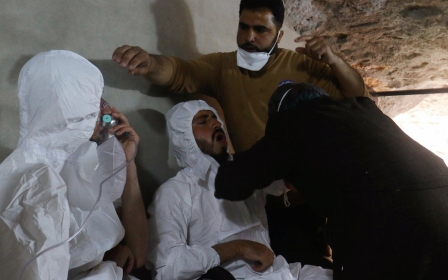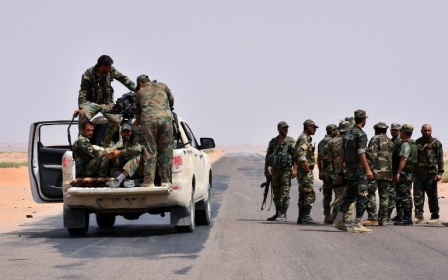Syrian army fights to secure corridor into Deir Ezzor
The Syrian army and its allies are fighting to secure a corridor to troops in Deir Ezzor, a day after they smashed through Islamic State (IS) group lines to break the militant siege.
The army reached Deir Ezzor city on Tuesday in a days-long thrust that followed months of steady advances east across the desert, breaking a siege that had lasted three years.
IS counter-attacks lasted through the day, the Syrian Observatory for Human Rights said. Fierce battles raged around the city as Syrian troops sought to expand the route and allow aid in, the British-based war monitor added.
"Work is progressing to secure the route and widen the flanks so as not to be cut or targeted by (IS)," said a commander in the military alliance backing Syrian President Bashar al-Assad.
"The next step is to liberate the city," the non-Syrian commander said.
It signals a tough battle ahead as the army aims to move from breaching the siege to driving IS from their part of the city, the sort of street-by-street warfare at which the militants excel.
Syrian state news agency SANA said the army had made gains expanding its control of the corridor after heavy artillery and air strikes.
Assad and his allies - Russia, Iran and Shia militias including Hezbollah - will follow the relief of Deir Ezzor with an offensive along the Euphrates valley, the commander said.
The Euphrates valley cuts a lush, populous swathe of green about 260km long and 10km wide through the Syrian desert from Raqqa to the Iraqi border at al-Bukamal.
The area has been an IS stronghold in Syria but came under attack this year when a US-backed alliance of Kurdish and Arab militias besieged and assaulted Raqqa.
Rapidly losing territory in Syria and Iraq, IS is falling back on the Euphrates towns downstream of Deir Ezzor, including al-Mayadin and al-Bukamal, where many expect it to make a last stand.
Still, the militant group specialises in urban combat, using car bombs, mines, tunnels and drones, and has held out against a full-scale attack for months in some towns and cities.
In Raqqa, the US-backed Syrian Democratic Forces alliance said it had taken about 65 percent of IS's former self-declared Syrian capital.
IS has 6,000-8,000 militants left in Syria, despite losing most of its territory across both Iraq and Syria since September 2014, the US-led coalition said.
Food convoys
Parallel with the thrust towards Deir Ezzor, the Syrian military and its allies have been fighting IS in its last pocket of ground in central Syria, near the town of al-Salamiya on the Homs-Aleppo highway.
On Wednesday, army advances gained control of four villages there, further tightening the pocket, a military media unit run by Lebanon's Hezbollah said.
Deir Ezzor lies along the southwest bank of the Euphrates. The government enclave includes the northern half of the city and the Brigade 137 military base to the west.
The army also holds an air base and nearby streets, separated from the rest of the enclave by hundreds of metres of IS-held ground and still cut off from the advancing army.
Government forces will push towards the besieged airbase, the pro-Assad commander said.
Instead of breaking the siege along the main road from Palmyra, stretches of which remain in IS hands, the army reached the Brigade 137 along a narrow path from the northwest.
The corridor from the west into Brigade 137 was only about 500 metres wide, the commander said.
The United Nations has estimated that 93,000 civilians were living under IS siege in Deir Ezzor in "extremely difficult" conditions, with some high-altitude air drops supplying them.
Deir Ezzor's provincial governor told state-run television that convoys loaded with food and medicine were on the way, along with ambulances and a mobile clinic. Residents in the enclave had gone years without vegetables, fuel and other necessities, Mohammed Ibrahim Samra said.
"Despite all this, the schools kept running," he said. "Our people in Deir Ezzor have suffered a lot ... and they still held on to their land."
Middle East Eye propose une couverture et une analyse indépendantes et incomparables du Moyen-Orient, de l’Afrique du Nord et d’autres régions du monde. Pour en savoir plus sur la reprise de ce contenu et les frais qui s’appliquent, veuillez remplir ce formulaire [en anglais]. Pour en savoir plus sur MEE, cliquez ici [en anglais].




